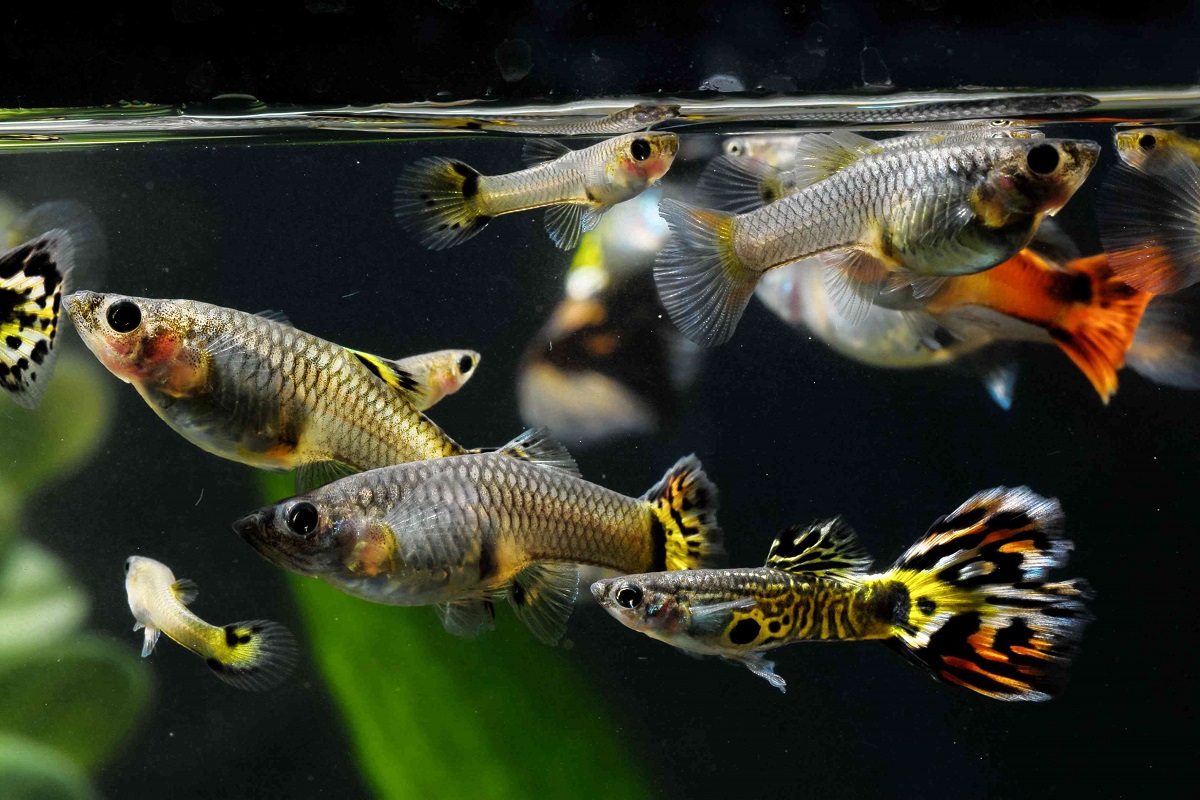If you just got a tank and are looking to buy your first fish, many experienced aquarists would advise you to start with an easy-to-keep species, like the guppy.
However, there are nearly 300 different species of guppies, all with different colors, tail shapes, and individual characteristics.
So, if you’re uncertain where to start, the following article is just for you.
We will talk about guppies’ different types, classes, and categorizations and arm you with knowledge before tackling your new hobby.
Contents
Different Types of Guppies by Species:
There are many different types of guppies, but they fall under these three main breeds.
Fancy Guppy (Poecilia Reticulata)
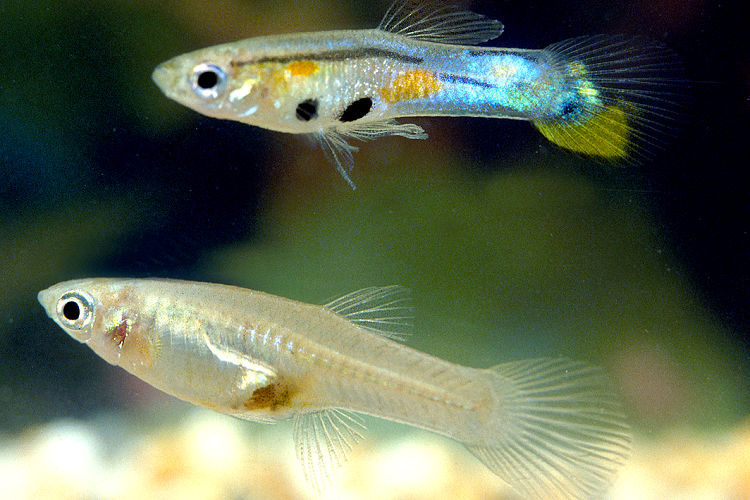
The scientific name, Poecilia reticulata, comes from the Greek and Latin words for speckled and a net-like pattern, respectively.
This is a widely available, hardy species. They’re otherwise called rainbow fish because of their magnificent coloring or “million-fish” because of their prolific breeding capability to birth live offspring.
The most common aquarium guppies are variations of the Fancy guppy.
Swamp Guppy (Micropoecilia Picta)
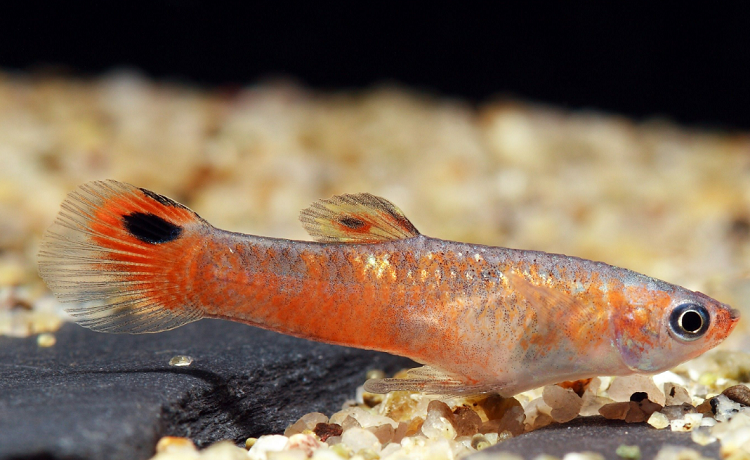
A biotope aquarium may suit this species with their liking for slightly alkaline and brackish water.
They are also called scarlet livebearers and thrive in a tank with some algae on a gravel base, where they can swim among plants.
Another name they’re given is painted guppies because of their rich red or orange coloring, and they birth live babies.
Endler Guppy (Poecilia Wingei)
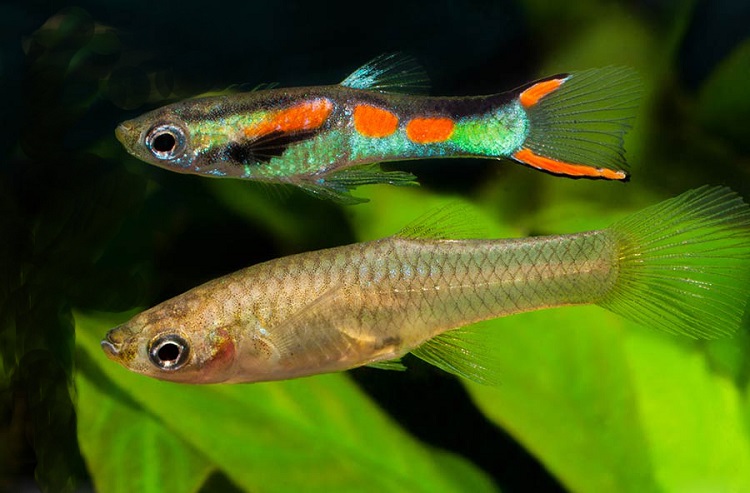
When the Poecilia Wingei was under threat of extinction, professor John Endler rediscovered the species in Venezuela.
Their coloring is usually metallic and silvery, and the female is the larger of the two.
However, this can change depending on the environment. Like other guppy species, they birth live babies.
Different Types of Guppies by Tail Shape
The different types of guppies listed in this article by shape are among the class of Poecilia reticulata or Fancy Guppies.
Fantail Guppy
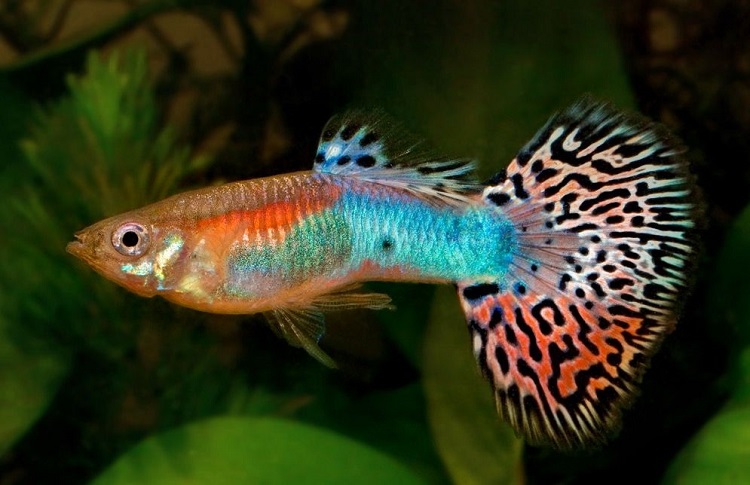
‘Fantail’ is an apt description of the colorful Poecilia reticulata. You’ll find it in the most magnificent ranges of bright pale blues to the deepest purples and reds.
In addition, males have elaborate caudal fins. They tend to prefer clean, freshwater tanks.
Veiltail Guppy
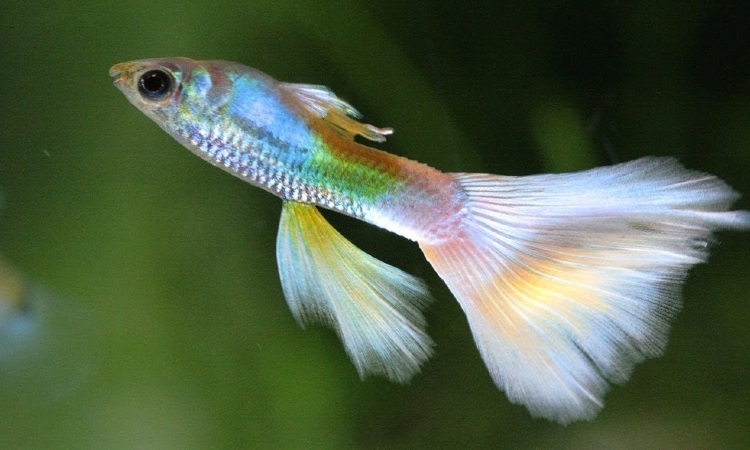
If, like me, you know little about the different types of guppies, you might wonder what the difference is between a Fantail Guppy and a Veiltail Guppy.
While both have symmetrical, isosceles triangle-shaped tails, the Veiltail Guppy’s is longer and more flowing, as is its dorsal fin.
Delta/Triangle Tail Guppy
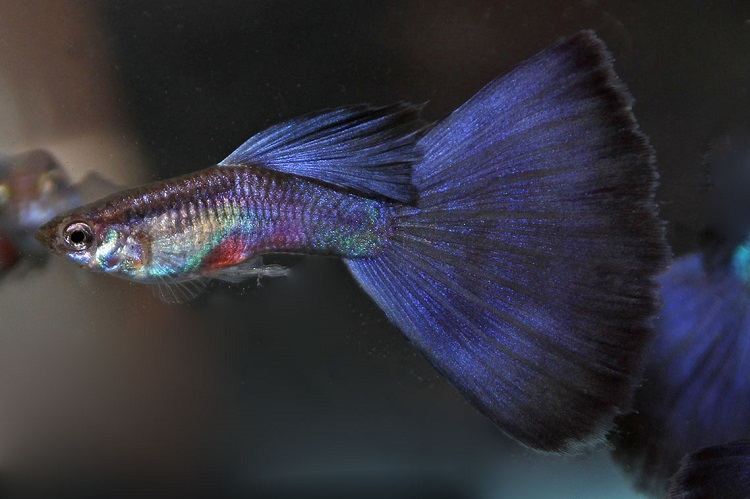
Again, this tail shape is so similar to the Fantail and Veiltail, but when you see it, you can’t help thinking of a river delta flowing into the ocean, with the ends flowing in an outward curve.
Also, their ventral fins are smaller. As a rule, the coloring of the delta guppy is two-tone from front to back, but genetic variations occur.
Scarf/Flag Tail Guppy

The tail of the Scarftail or Flagtail Guppy is slightly shorter and narrower than in other species.
Also, when the Scarftail guppy swims, its tail flows behind it, giving the appearance of a flag blowing in the wind. Like other species of guppy, the colors can be spectacular.
Double Swordtail Guppy
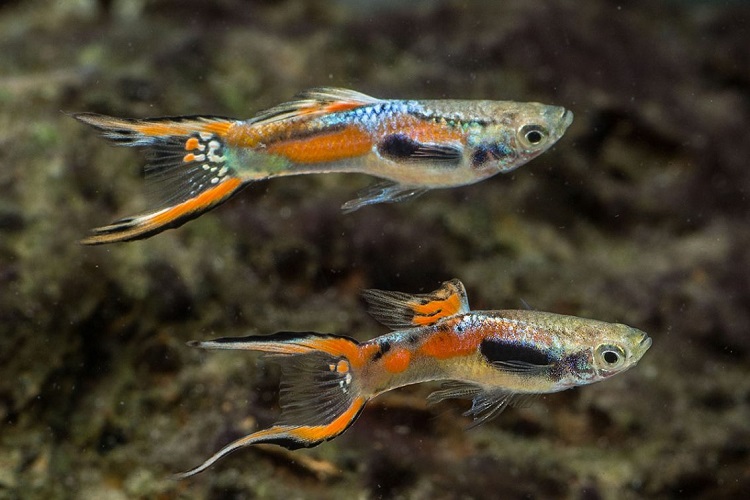
These fish are primarily olive green in the wild, but genetic mutations in captivity have resulted in many colors.
Like other guppies, the double swordtail guppy derives its name from the shape of its tail. The top and bottom of the tail extend into swordlike protrusions.
Top Swordtail Guppy
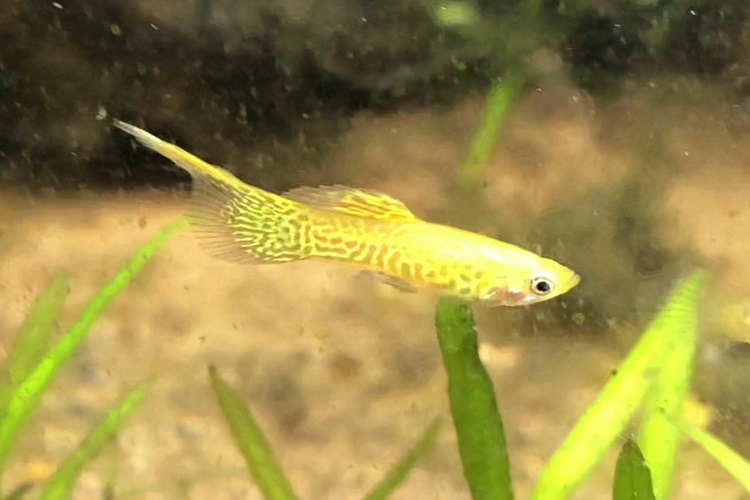
While similar to the double swordtail guppy, only the top part of the tail extends into the swordlike protrusion. The colors of Swordtail guppies in captivity are varied because of genetic adaptions.
Bottom Swordtail Guppy
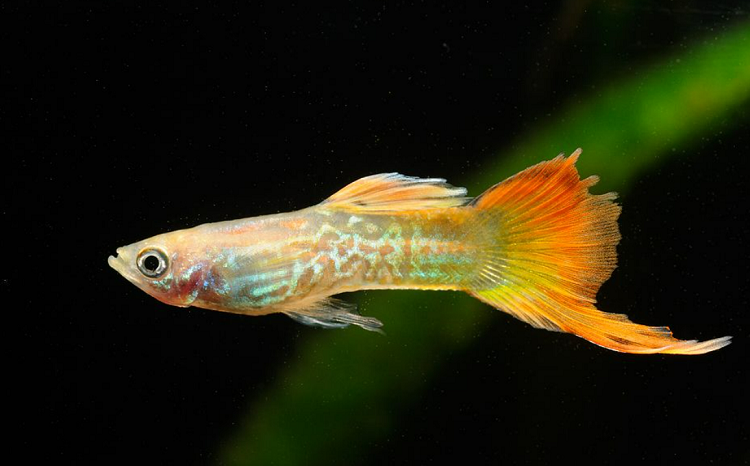
Again, similar to the Double Swordtail Guppy and Top Swordtail Guppy, the bottom part of this one’s tail extends into the swordlike protrusion.
Lyretail Guppy
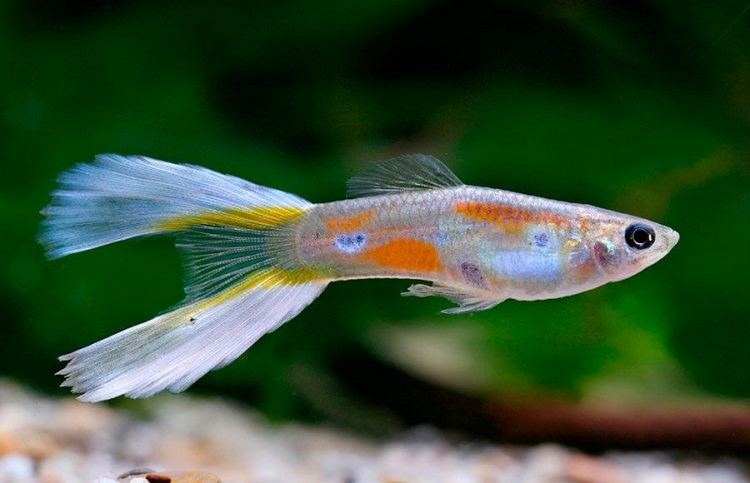
These exceptionally colorful, patterned guppies have a unique ‘fingerprint’ in their colors and markings.
They are gray with splashes of color and hardier than their brethren. They have teeth on their upper and lower jaws.
The white-tailed, Lyretail guppies are usually silver, green, or red.
Spear Tail Guppy
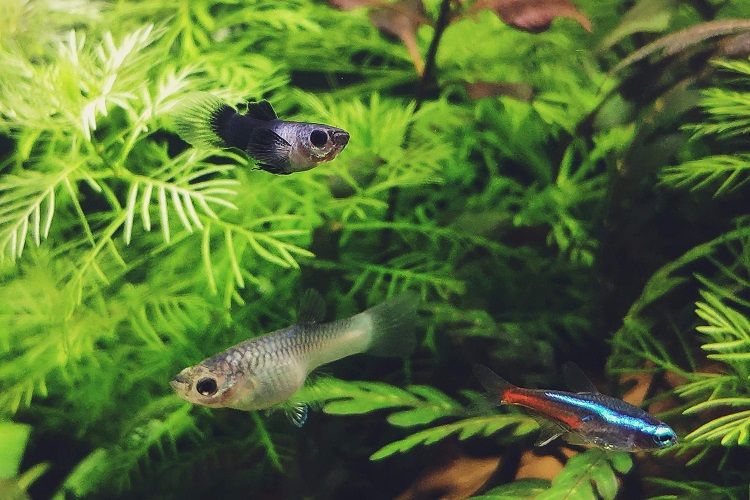
Spear tail guppies have an unusual appearance. As one of the uniquely different types of guppies, they’ll definitely draw your eye when in aquariums.
While the tail has rounded edges, it’s a type into a point at the end, very similar to the head of a spear. Its dorsal fins are also an unusual shape and take about a third of the body links.
Roundtail Guppy
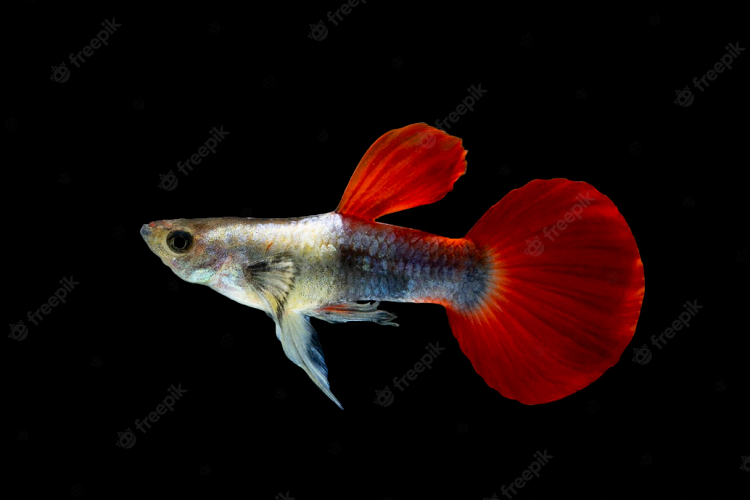
The round tail guppy is not dissimilar to the spear tail guppy in that the dorsal fin flows towards and becomes a part of the rounded tail.
These come in a large variety of shades and patterns and can become a unique-looking addition to your home aquarium.
Pintail/Needle Tail Guppy
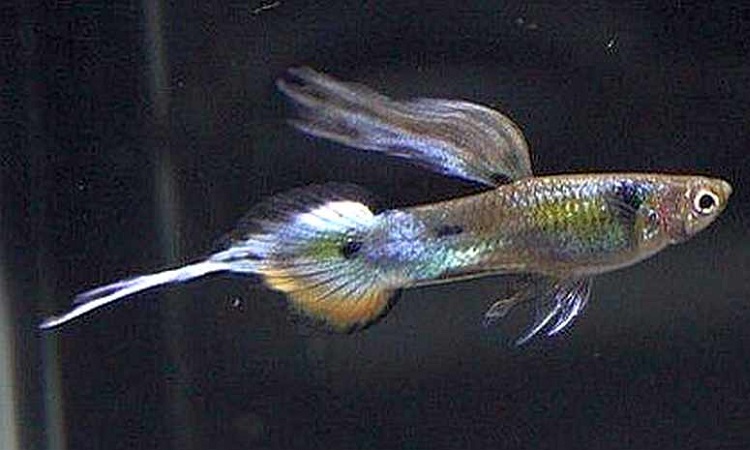
This is probably the most easily distinguishable and beautiful of the guppies.
The rounded tail ends in a sharp, narrow point like a needle. You can find the species in a wide variety of colors.
Halfmoon Tail Guppy
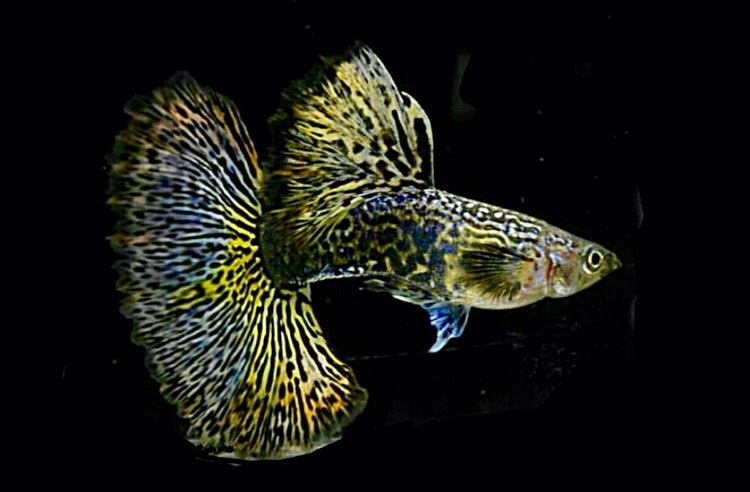
While the halfmoon tail guppy is similar to the round tail guppy, the halfmoon tail has a much larger tail or caudal fin.
Also, the tail fan angles away from the body at 90° before arching into the half moon.
Cofertail Guppy
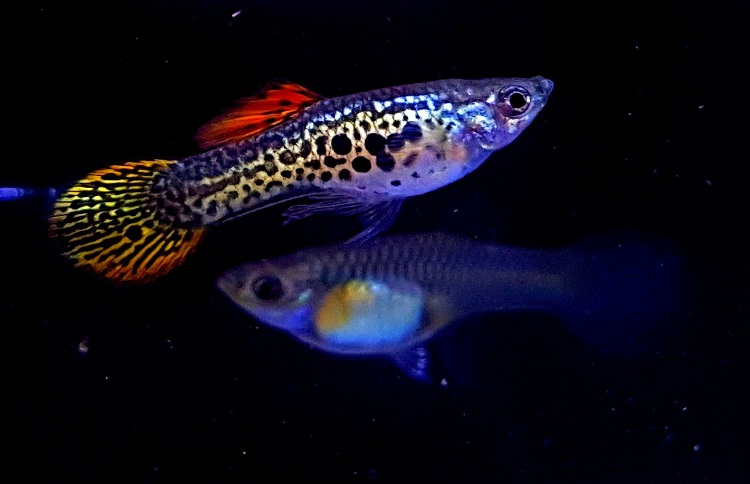
This is also known as the spade tail guppy. And while the fish is small, the tail extends outward by half the body length, resembling a shovel or spade.
Different Types of Guppies by Body Pattern:
Next, we will list different types of guppies based on their body pattern.
Cobra Guppy
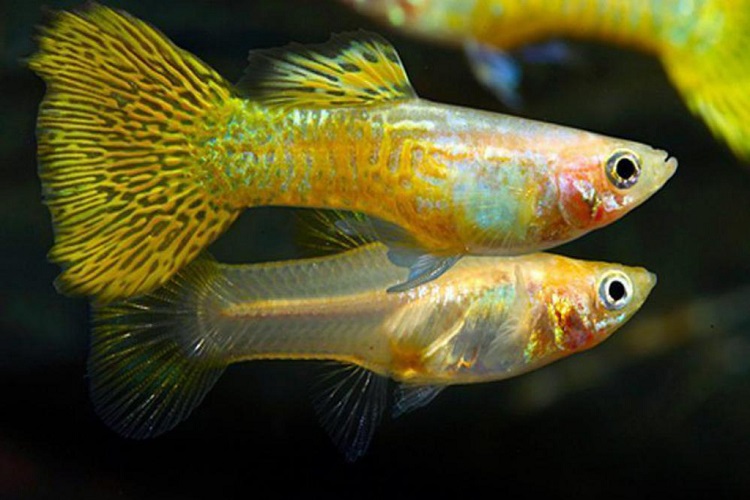
While Cobra Guppies come in many color varieties, the reticulations in their patterning and the vertical black bars that sometimes run across their bodies give the impression that you are looking at a cobra’s skin.
In addition, they have more prominent tail markings than on their bodies.
Tuxedo Guppy
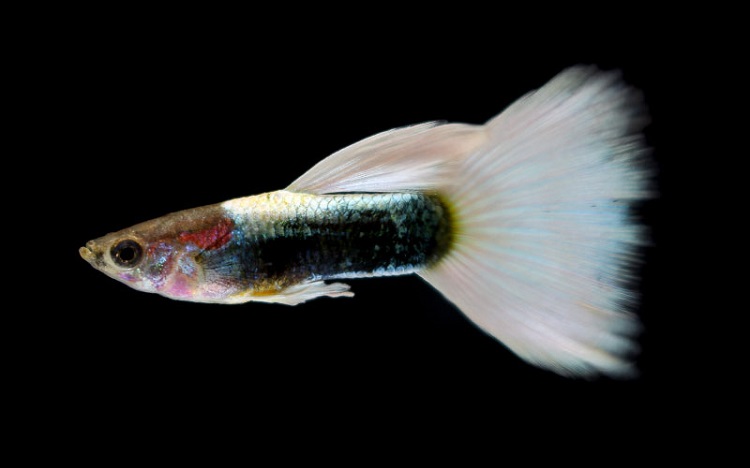
Originally bred in Germany, the tuxedo guppy has an elegant appeal.
The top half of the body, or head, is a different color to the rest of the body, sometimes black, sometimes other colors.
The tail end dorsal fin is usually a different hue of the same color as on the head.
Snakeskin Guppy

Another of the many color variations of the guppy is the snakeskin guppy.
Changes may be observed within the multiple colors of the snakeskin guppy, pattern, and color, due to genetic variations.
For example, the snakeskin appearance in yellow males covers the entire body and fins.
Different Types of Guppies by Tail Pattern:
Tail patterns are useful when telling the different types of guppies apart. The style, as well as the tail color, help us distinguish the following guppies.
Lace Guppy
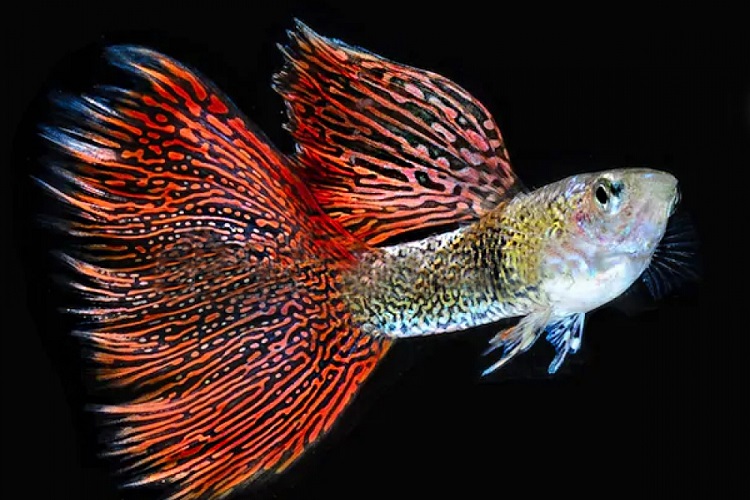
The Lace guppy is not entirely dissimilar to the cobra guppy in the patenting of their scales. However, it does not have vertical bars running across its body.
The Lace Guppy also comes in a wide range of colors.
And occasionally, the tips of the tail and fins may be a different color, giving the guppy an elegant touch.
Glass Guppy
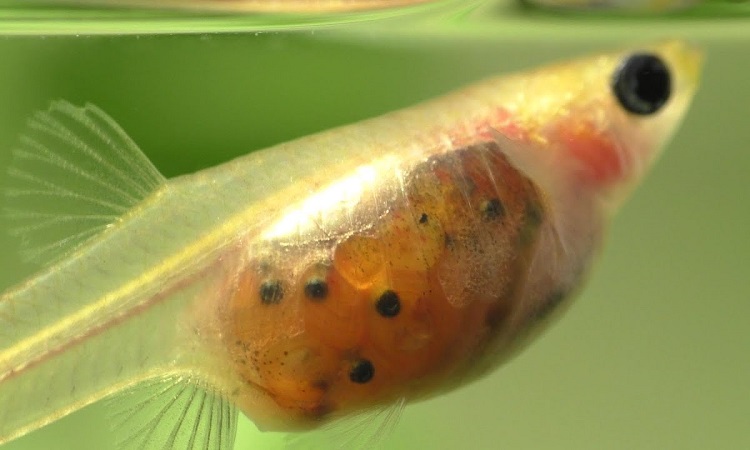
The highly unusual coloring of the glass guppy makes it one of the uniquely most unique ones on our list.
They are entirely translucent since they have no black or silver pigmentation. You can literally observe the eggs and babies inside the mother.
Mosaic Guppy
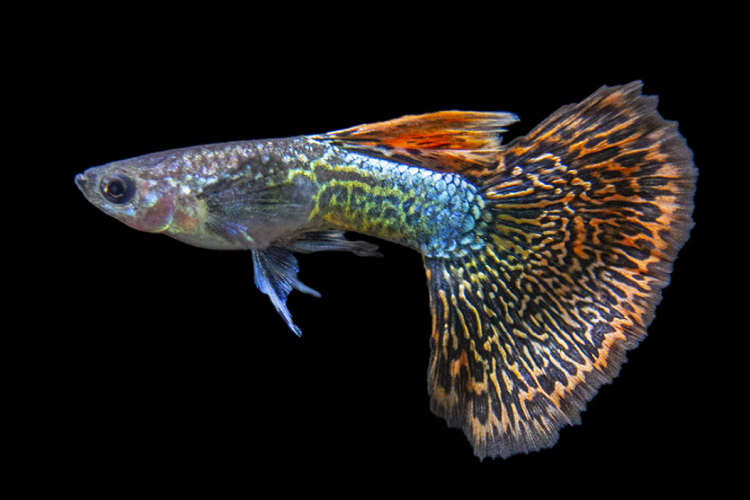
You could find a mosaic and shades of red, violet, orange, blue, and yellow.
It has become relatively well known among aquarists, and females are also brightly colored.
Leopard Guppy
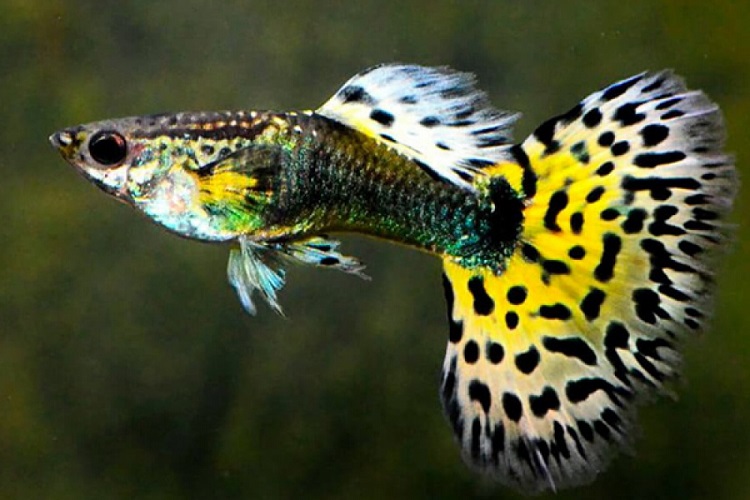
The leopard-like markings on its body and fins distinguish the leopard guppy from different types of guppies.
The color ranges from pale yellow to quite a dark orange.
Different Types of Guppies by Color:
When looking at the colors of different guppies, you’ll find several in this category.
Albino Guppy

Because these guppies have no pigment, the color appears to be pinkish-white.
Their eyes also have no pigment and are slightly reddish, making them easily noticeable compared to other white breeds.
White Guppy
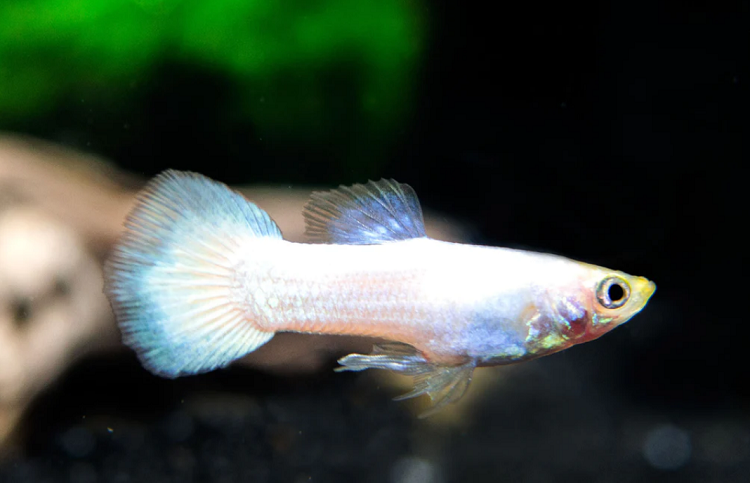
The white guppy, also known as the platinum guppy, is popular for beginner aquarists.
They add a beautiful snow-like touch to the aquarium aesthetic.
Black Guppy
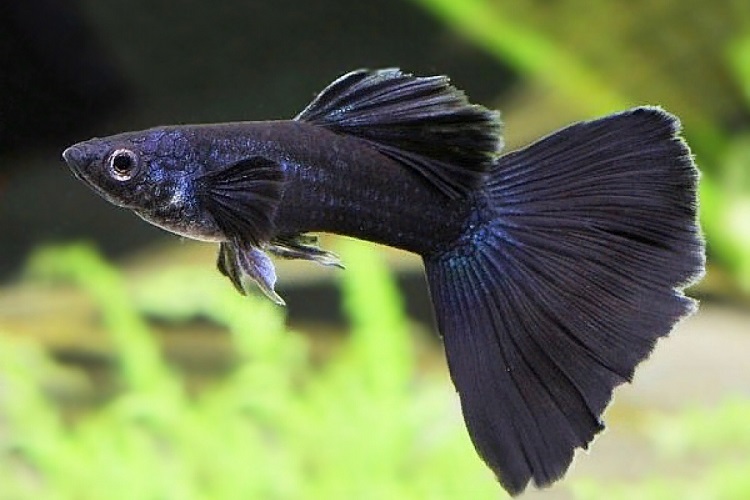
Black Guppies come in a range of tail shapes: round tail, pintail, spear tail, swordtail, lyretail, spade tail, flagtail, veil tail, fantail, and triangle tail.
In the case of a black delta tail guppy, the tail is black, and the front, or head, is white or silver-ish.
Red Guppy
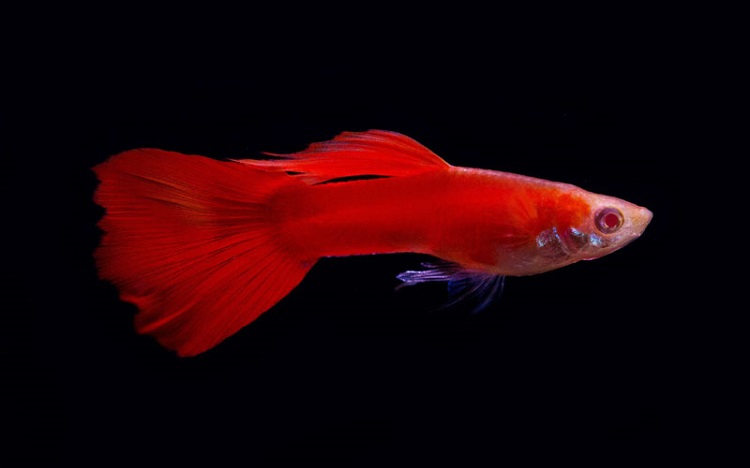
The Red Guppy has a solid predominant red color with a slight variation over small areas.
There are several predominantly red guppies, such as the Albino Full Red, Flamingo Red, Full Red Gold, and Moscow Red.
Blue Guppy
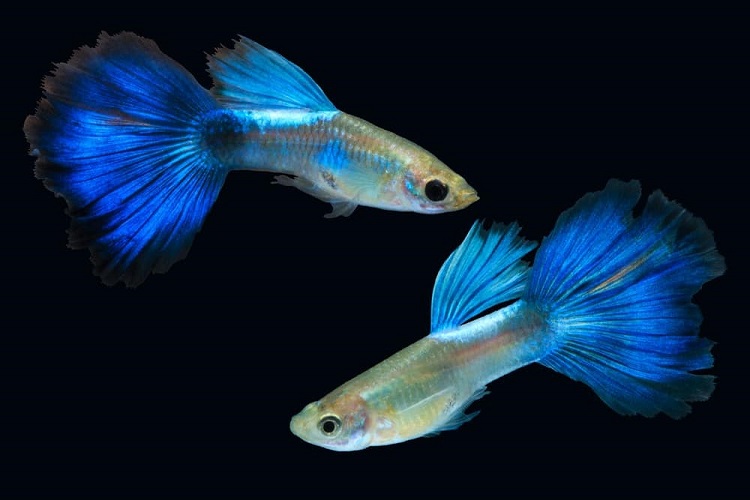
The tail of the Blue Guppy is a beautiful electric blue.
In most, this is true for the entire body, except for the delta tail variant, where the body may be brown or silver. If in a Guppy, the body is red, and the tail is blue, it is known as a Blue Guppy.
Neon Blue Guppy
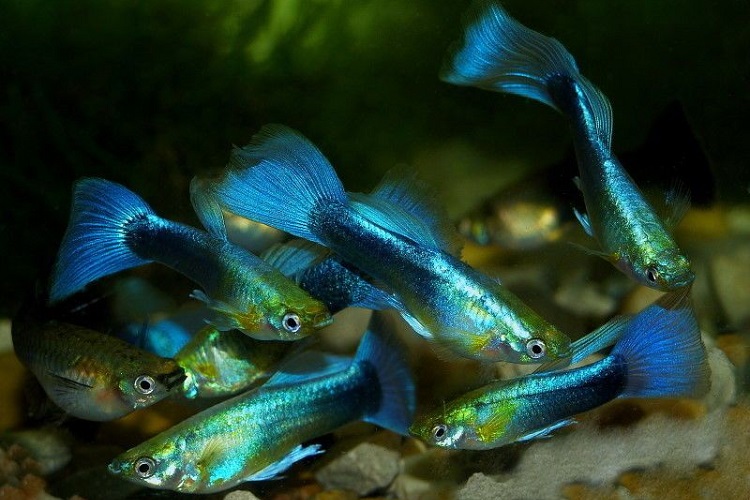
Neon Blue Guppies are…well…a bright neon blue; however, the color is paler than the electric blue we mention above.
Also, the absolute color depends on the style of the tail.
Japanese Blue Guppy
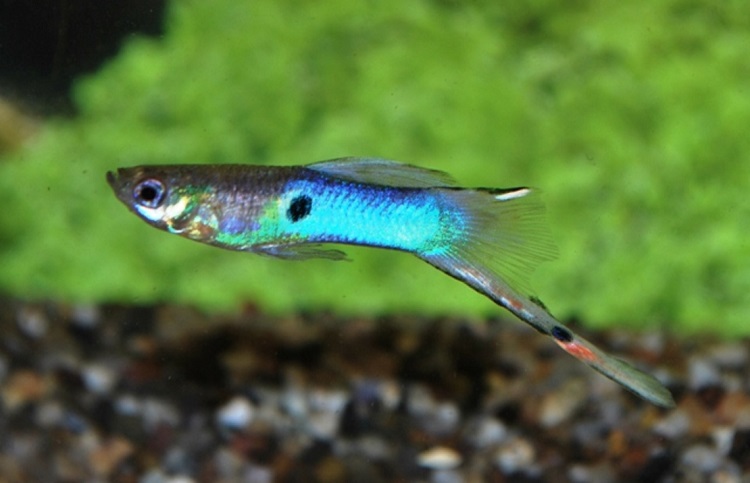
This Guppy can range from a metallic sky to deep blue. The swordtail variety is a common choice among aquarists.
The head may often be silver in a delta tail, while in the Leopard Guppy variety, the tail can have a decorative display of tiny black dots.
And here we have our first Swamp Guppy (Micropoecilia Picta) instead of the most commonly known Fancy Guppies.
Green Guppy

Like the solid coloring of the guppies mentioned above, the Green Guppy has a solid green coloring, somewhere between olive and avocado green.
This, too, is influenced by the tail style—which, as mentioned before, is always the predominant color.
Yellow Guppy
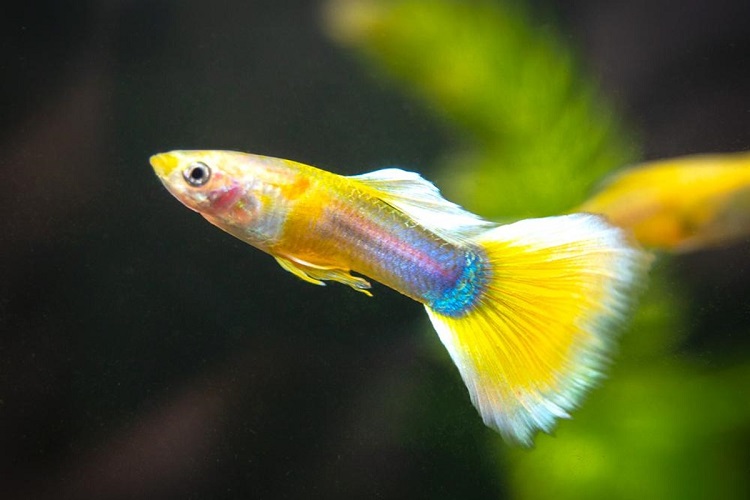
The yellow guppy will always have a yellow tail. This may range from the palest to the deepest, almost orange, yellow color.
However, the body coloring may vary depending on the tail style.
Purple Guppy
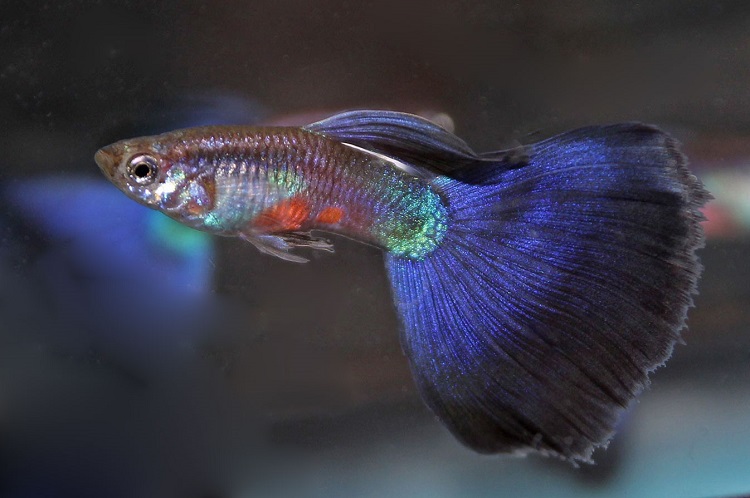
The tail and fins of this guppy are, well, you’ve guessed it, purple.
It may be a brilliant, bright, pale purple or a deep, midnight purple that expands from the tail over at least half of the body. The body coloring will vary by tail style.
Bronze Guppy
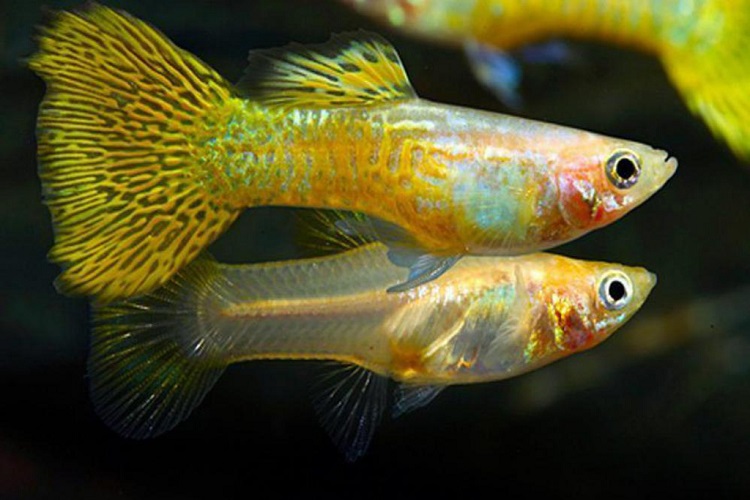
In the case of the bronze guppy, at least 25% of the scales must be rich bronze color.
While the tail may often be bronze, it’s not always the case.
Golden Guppy
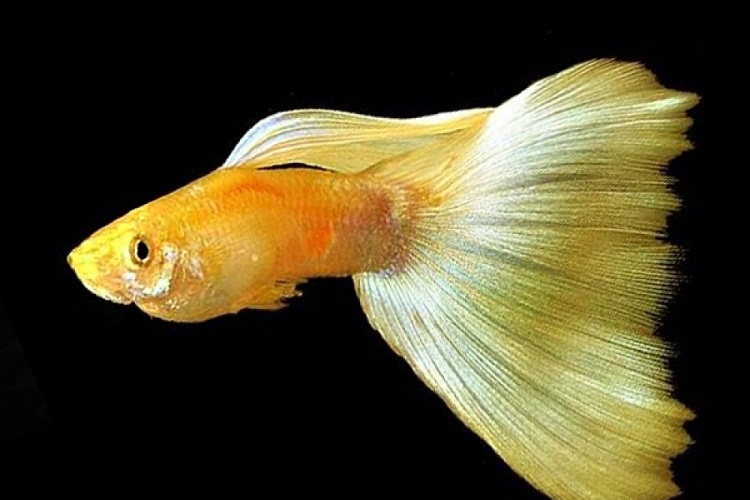
Again, this color is determined by the color of the scales and not the tail, though the tail will often be a similar shade of gold—from a light, bright, pale gold to deep, exotic gold.
Half-Black Red Guppy
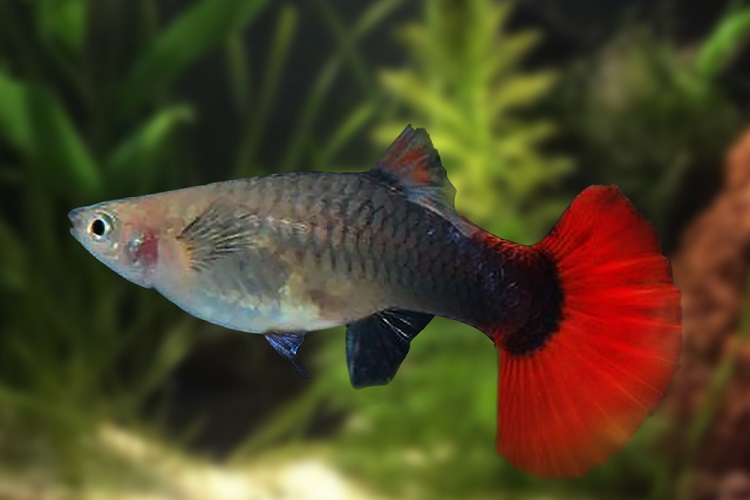
The half-black coloring of this guppy is usually around the guppy’s mid-section; the head and the fins will usually be a similar bright red as the tail, though it may have other colors, too, like white.
Half-Black Blue Guppy
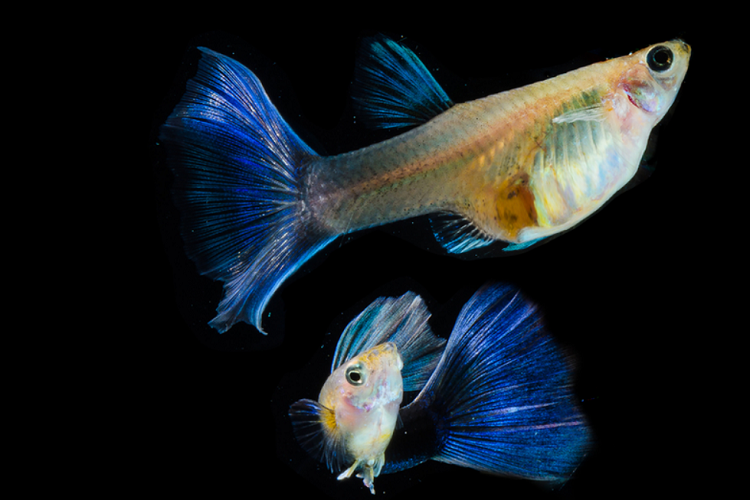
Again, the tail may be electric blue or black, and the midsection, black. The front (head)is often a lighter blue or gray.
Half-Black Green Guppy
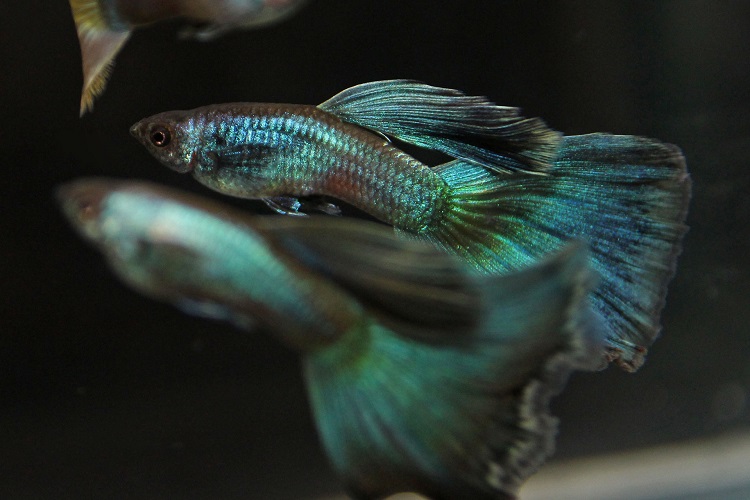
In the Half-Black Green Guppy, like the Half-Black Blue Guppy, the tail may show up in a bright or olive green or black, with the midsection being black.
Also, the head is likely a very pale green, white, silver, or gray.
Half-Black Purple Guppy
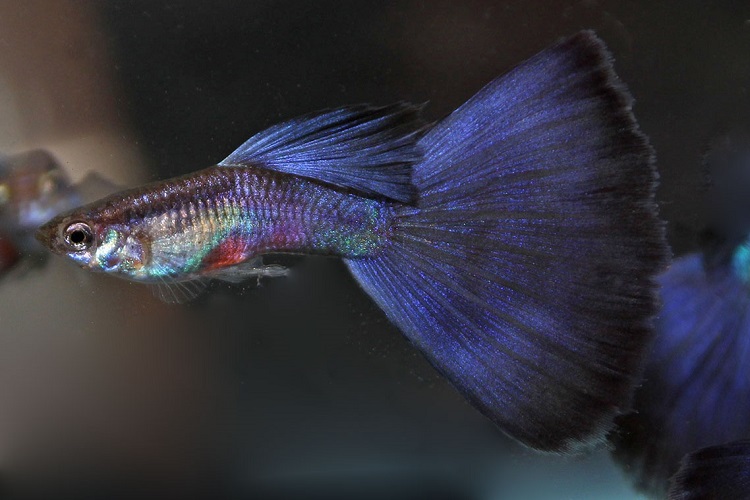
The tail and fins of the Half-Black Purple Guppy are typically a bright purple but may be lighter, while the midsection is black, and the front section may be lighter.
Half-Black Yellow Guppy
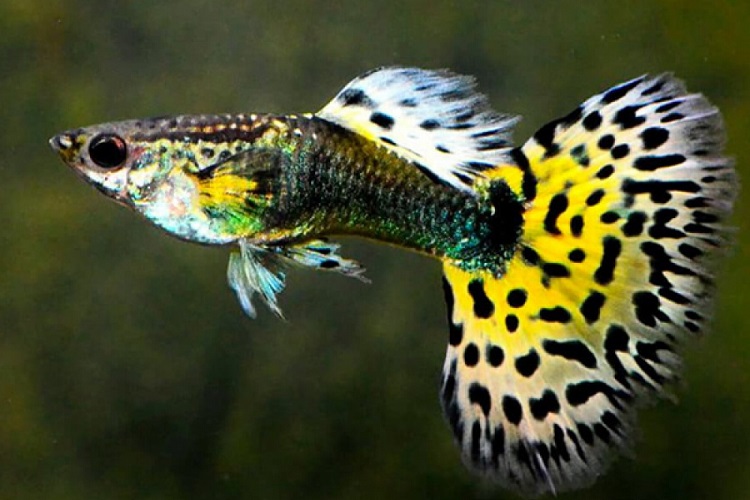
Their tail and fins could be a solid pale or bright yellow and may have Leopard Guppy markings.
The midsection can range from dark gray to midnight black, while the head is a lighter color, either yellow, silver, or gray.
Half-Black Pastel Guppy
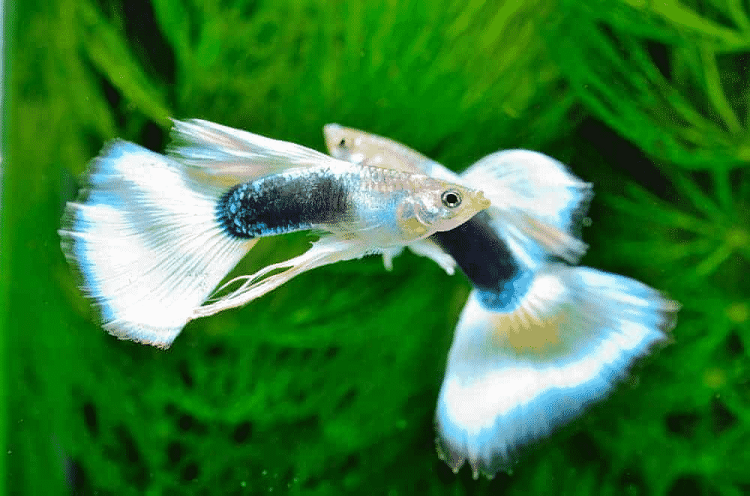
These pastel colors often seem neon in nature. They present a striking contrast to the black or gray of the midsection and paler head.
They come in a wide variety of pastels besides yellow. The caudal or tail fin is typically a pastel-like white color.
Solid Colored Guppies
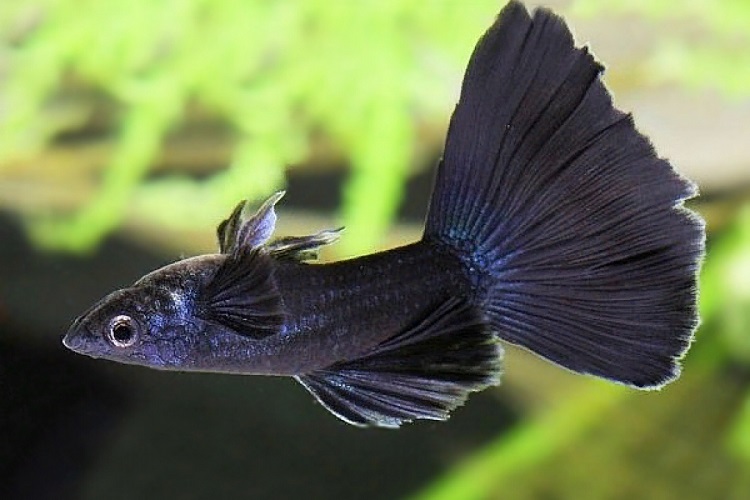
Solid Colored Guppies are usually bright and eye-catching. Even when they’re of the paler variety, they’re unmistakable.
They come in blue, purple, black, green, orange, and red.
Metal Guppies
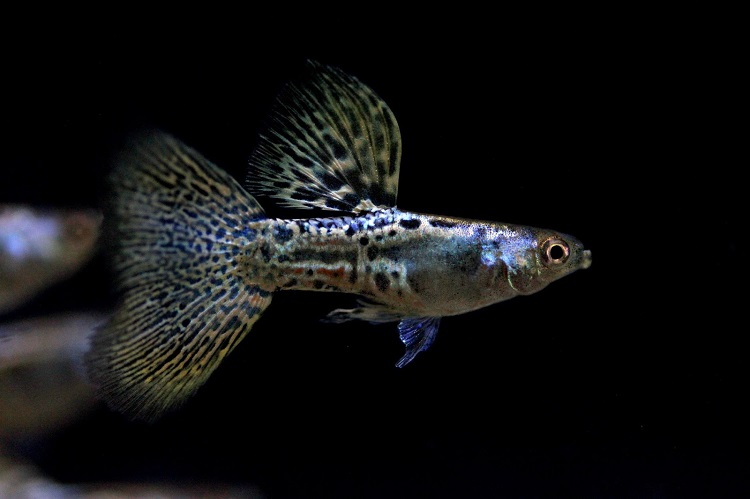
Metallic Guppies have the unique ability to conceal themselves from predators.
This is due to crystalline chemochrome plates on their bodies and tales. These reflect light and thereby blend the fish into the background.
Koi Guppy

These guppies are rare and have the appearance of the traditional Koi fish.
The coloring ranges from bright orange or dark blue, with the common white coloring of the Koi fish. They can also come as albino guppies or with various tail styles.
Panda Guppy

The panda guppy fish looks like a panda bear. Their dorsal and ventral puns might be black, blue, or red while the body may be white.
Moscow Guppy

The Muska guppy fish has a bit of a reputation that was originally bred in Russia and smuggled into the US.
It is larger than other guppies, with bigger dorsal and caudal fins. Also, they are usually solid colored.
Platinum Guppy
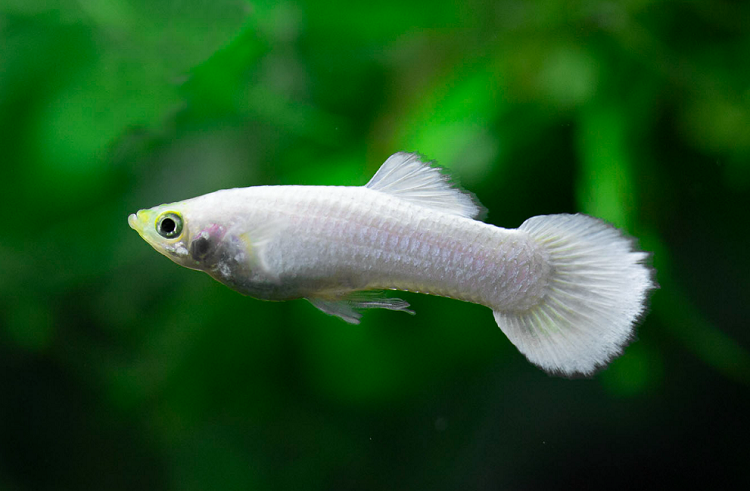
The platinum guppy fish frequently has an albino or body with pearlescent scales.
With their striking coloring, these guppies make a beautiful addition to the fish tanks of beginners or seasoned aquarists.
Bi-Colored Guppy
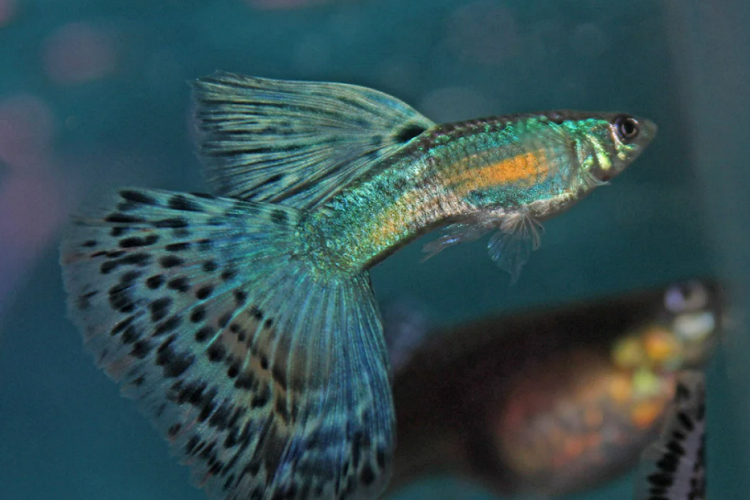
To be classified as a no-colored guppy, there needs to be a base color and a secondary color.
Any third color may not take up more than 15% of the body, and the secondary color must take at least 25% of the body. The fins must also be in the secondary and not the primary color.
Multi-Colored Guppy
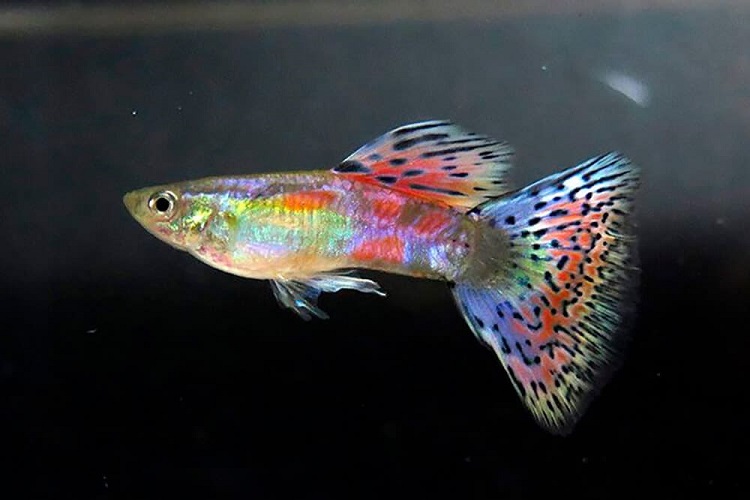
The multicolored guppy has brilliant variegated colors of blues, reds, and greens.
While in the male species, these colors cover the entire body and fins, the female is also exceptionally brightly colored.
Dragon Head Guppy
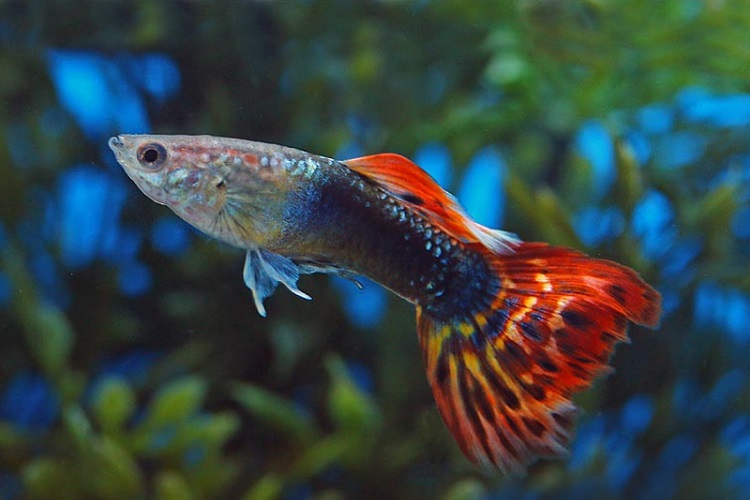
These guppies come in various bright colors, including shades of violet, red, orange, purple, yellow, and blue.
Jarawee Lazuli Guppy

This guppy is named after the aquamarine stone of lapis lazuli. The bright blue head is similar to that of the Japanese blue guppy.
It’s also known as the green algae guppy due to its coloring and stands out in any aquarium tank.
Different Types of Guppies by Eye Color:
There are two different major types of guppies when it comes to eye color.
Real Red Eye Guppy
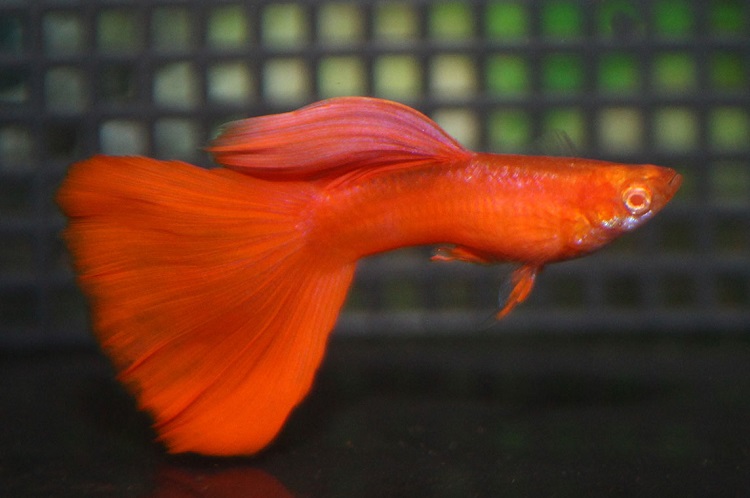
Real red-eye guppies have eyes that are actually red. The bodies are smaller than other guppies, and their eye coloring is darker than the albino guppies’ eyes.
Real Red Eye Albino Guppy

The real red-eye albino guppy has no melanin pigment in the eye, making them pure red. Their eyes are lighter than those of the real red eye guppy.
Other Different Types of Guppies:
These two different guppies fall under a separate category, though they could fall under the guppies listed by tail shape or color.
Dumbo Ear Guppy
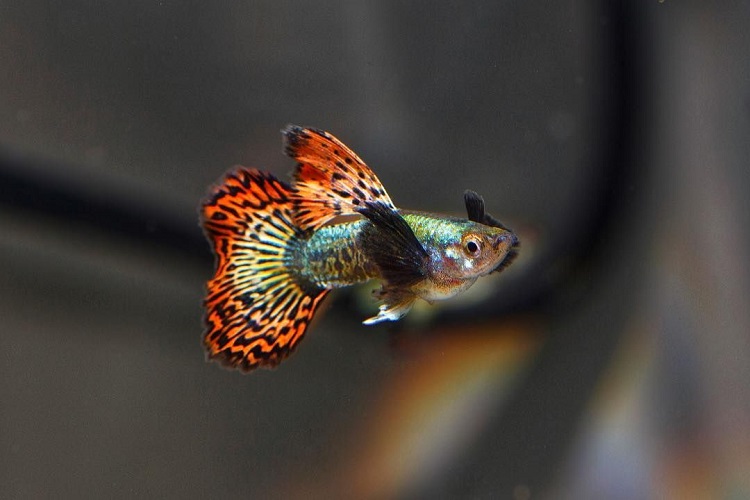
The colorful red mosaic Dumbo ear guppy has extra large pectoral fins. These resemble the ears of an elephant.
Both males and females come in bright red, orange, blue, violet, and yellow.
Mutt Guppy
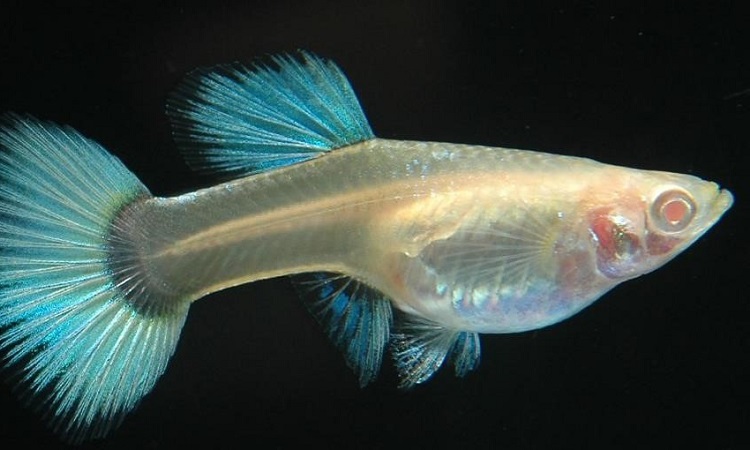
The genetic changeability in the mutt guppy results in them being healthier than others. This makes it easier to keep them in home aquariums.
Interesting Facts About the Guppy Fish
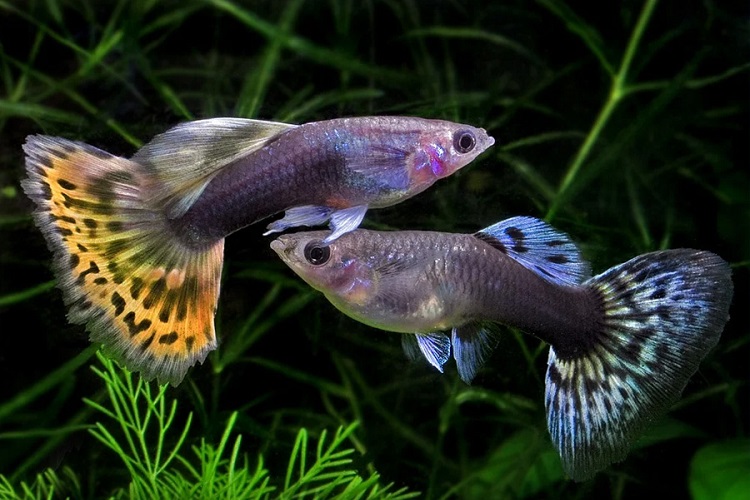
Science Direct speaks of the Poecilia reticulata as highly polyandrous, meaning the females have multiple male partners.
All the different guppies listed above are prolific breeders and birth approximately 100 offspring every month through both consensual and forced mating.
Guppies can survive in the largest river deltas and the smallest streams, cohabiting areas with larger fish.
In Tibet, they can be found above barrier waterfalls where the only other fish to survive is the killifish, who may occasionally prey on the guppy, though they usually opt for a diet of insects.
Interestingly, professor John Endler rediscovered the near-extinct Poecilia Winge and found that guppies in predator-filled downstream waters were less brightly colored than their upstream counterparts.
While females prefer to mate with brightly colored males, fewer such males survive in predator-rich waters.
Difference Between Male and Female Guppies

There are seven main ways to differentiate between male and female guppies, which is notable in all variations of the different types of guppies.
- While males tend to be longer and thinner in body shape, females are slightly rounder and larger. Males reach a length of approximately 1-1/8th inches and females up to 2-1/8th inches.
- Like most within the animal kingdom, when it comes to color, it’s up to the males of the species to shine. The brighter and more beautiful the color, the more likely the guppy is to attract female attention.
- The anal fin, or the fin on the underside of the guppy near the tail, is longer and more pointed on the male. This allows the gonopodium or male reproductive organ to insert sperm into the female.
- If looking at the dorsal fin at the top of the guppy, you’ll notice that the male’s dorsal fin flows or trails while they swim, while the female’s does not.
- The tail fin, or caudal fin, is another tell. The male’s is brightly colored and more flowing than the female’s slightly shorter tail.
- On the female, you may see the gravid spot—the female reproductive organ. It’s a small, dark area near the tail fin. The darker the spot, the closer the female is to the time of giving birth.
- A final factor to consider is that, from birth, females tend to grow faster. But this may also be due to superior nutrition, so it’s not a hard-and-fast rule.
Can You Mix Different Types of Guppies in a Tank?
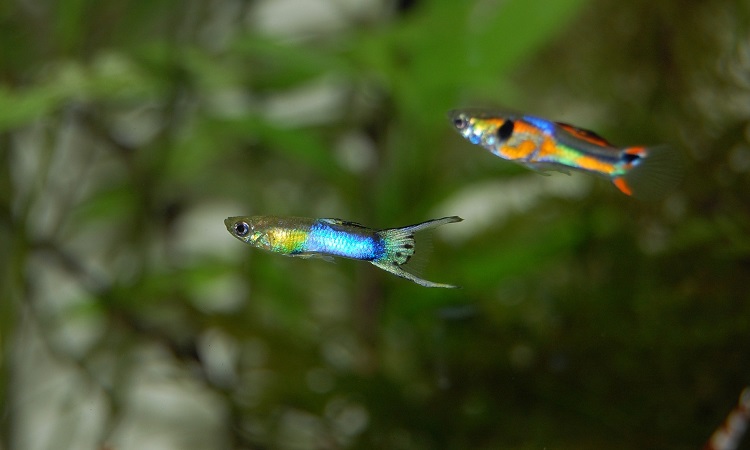
Not only can multiple guppy species commune in one tank, but they can harmoniously reside alongside others of the more peaceful fish species.
In so doing, you’ll create a diverse fish ecosystem with an explosion of the most spectacular colors.
You’ll need to consider a few things, though. Most importantly, the various fish species would require similar conditions to thrive.
Also, your tank would need to be large enough to cater to future generations since these fish breed so abundantly.
Conclusion
Learning about the various types of guppies—the different species and whether they will suit your home aquarium—will help you make an informed decision about whether this is the right fish for your project.
The article goes through different types of guppies by species, their appearances, and their preferential habitat.
Generally, guppies are hardy fish, but it’s a good idea to have an understanding before you decide which color, tail preference, etc., you’d like.
We hope that we helped you and you got the answers you’ve been seeking.
Resources:
- ScienceDirect.com
- ResearchGate.net
- TFHMagazine.com
- JapaneseFightingFish.org
- ScienceDirect.com
- TankFacts.com

Ian Sterling, founder of Fishlab.com, began his aquarium journey over 30 years ago, driven by a deep fascination for fish and their diverse personalities. His website, Fishlab.com, is dedicated to making fishkeeping accessible and enjoyable, offering beginner-friendly guidance, expert insights, and a community for aquarists to connect and share experiences.


